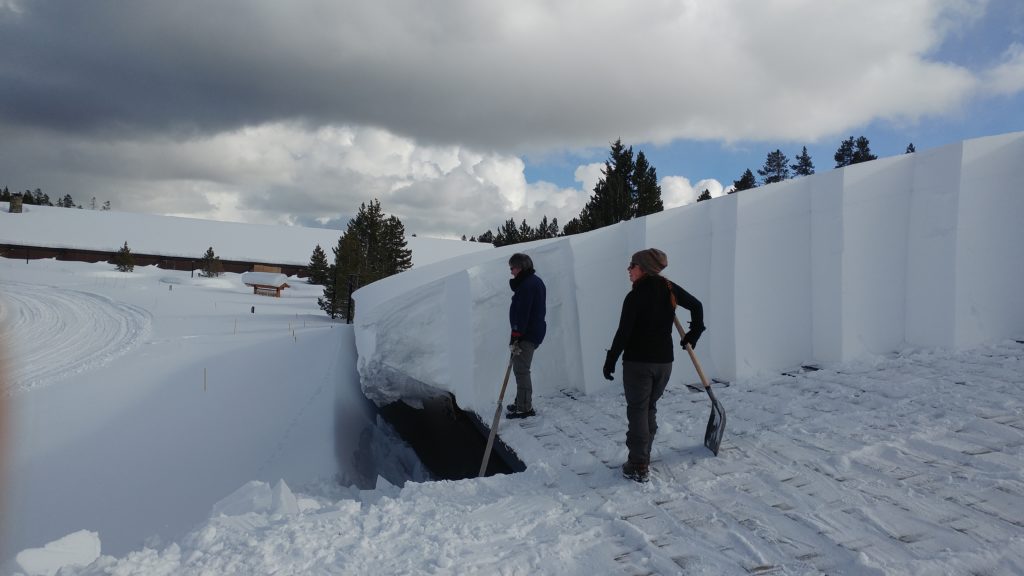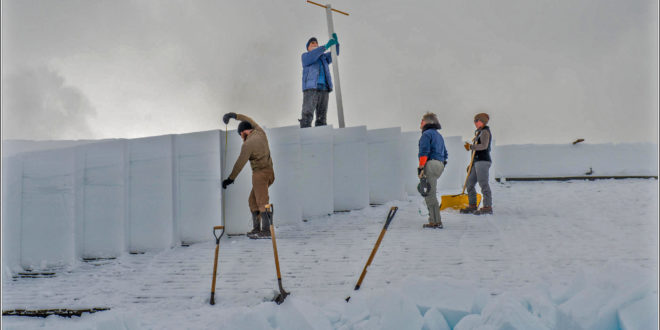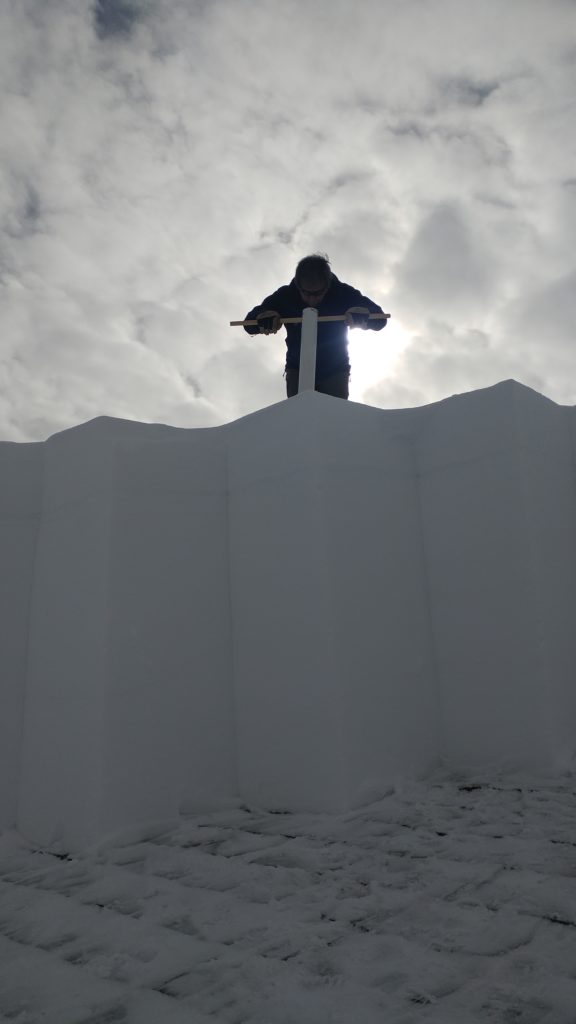What comes down must get shoveled off, at least in Yellowstone winterkeeper Jeff Henry’s wintry world.
For nearly 40 years, Henry has cleared snow off the roofs of some of Yellowstone National Park’s most historic structures.
To hear Henry, 64, tell it, he is one lucky dude. He’s got a job he loves in a place he loves, and he absolutely can’t imagine doing anything else.
Henry is a well-known winterkeeper in Yellowstone National Park. You’ve seen the photos—he’s a burly fellow, dark-haired and bearded, most often photographed on the roof of the big general store at Canyon Village, swinging a saw nearly as tall he is, that looks like it came out of one of those old Pacific Northwest logging camps from the turn of the century. With those saws – and some winters when the snow is set up particularly hard—chainsaws—Henry cuts 6-foot deep snow into 600 pound blocks that he shoves and drags and pushes over the edge of the building.
Repeat.
Henry does this for 23 buildings scattered between Canyon, Fishing Bridge, Grant Village, Lake and Old Faithful, he explains via cell phone. He says he’s standing on top of the Canyon General Store as we spoke a couple of weeks ago.
Henry has worked for various entities over the years, but he currently works for Delaware North Corporation. DNC has a concession contract with the National Park Service to operate the park’s general stores, which were founded by Hamilton Stores.
The big store at Canyon alone has half an acre of roof, Henry said. He estimates that 1 million pounds of snow can accumulate there. Canyon is the highest elevation developed area in the park and consequently gets the most snow.
This winter, of 2016-2017, may be his fourth-most snowiest, following the winters of 1996, 1997 and 1999 are the biggest snow years he recalls.
“This is the hardest winter I’ve ever had,” he said. “There have been strong winds that created a lot of drifting. We had some rain (in early February) that created ice layers in the snow that are really hard.”
In fact, while we’re speaking on the phone, the wind picks up and drowns out his voice over the phone. He hops down off the roof and heads to the Canyon Visitor Center to get in out of the wind and talk indoors.
Henry has other ancillary duties during the winter. He checks on buildings, makes minor repairs, and reports other issues. He’s come across leaking propane lines and trees that had fallen on structures. He works on his tools and keeps his snowmobile in running order.
Even something as simple as dressing is a job. There are layers of clothes, hats, gloves and gaiters. And in the evening, it takes a while to get it all off again and hung up to dry properly for the next day.

Getting Ready In The Fall
Henry maintains two seasonal residences in the park in winter—an apartment at Canyon and a cabin at Old Faithful. In the fall before the roads close for the season—usually around Nov. 1—he hauls in his tools, which include about 50 shovels and numerous saws, ladders and basic hand tools.
He also has to stock a food supply at each residence—dry, canned and frozen foods. He tries to eat healthy food, and he needs plenty of it when he’s outside working hard in cold weather. He supplements his stored food with fresh whenever he makes a trip to the outside world, which means snowmobiling 30 miles from Old Faithful to West Yellowstone or 33 miles from Canyon to Mammoth Hot Springs.
Henry says he’s become an expert at packing and loading a snowmobile trailer with supplies. He packs nearly everything into coolers—he estimates he owns 50-60 of them. Coolers help keep frozen food cold, but can also insulate perishables that shouldn’t freeze, like eggs. A couple of tricks he has include packing warmed up slabs of soapstone in a cooler to help keep things from freezing, and he uses chemical hand warmer packets, too.
Henry even packs his clothes in coolers, and they’re a great storage container for keeping mice out of things. Space is tight in his winter residences, so Henry places his beds up on blocks to create enough height to store coolers underneath.
Climate Change
Over the years, he said he’s seen evidence of what might reasonably be called climate change, and he noted some examples as evidence.
When he started in the late 1970s, there was never any rain in the winter. Now there’s at least one rain event almost every year.
Snow comes later in the fall than it used to. Snow used to begin to reliably accumulate around Nov. 1, now it’s mid-November.
Overnight temperatures more often drop to only barely below freezing.
“We used to have weeks at a time with below zero temperatures overnight, and even weeks at a time when daytime highs didn’t get about zero,” Henry recalled.
Cold snaps of -25 to -30 were more common. Now, if they come, the cold snaps don’t seem to last as long.
Recent winters seem windier. This winter, there were days with the wind blowing the snow around in whiteout conditions, he couldn’t see his next step.
Henry has even noticed that he’s using warmer waxes on his cross-country skis.
“I would use up my cold waxes, and my warm waxes were nearly untouched. Now it’s different. I tend to use the warm waxes much more often,” he said.
Weather patterns seem more erratic with more annual variability, but the overall trend seems to be less snow with a later onset and earlier melt-off.
His Background
Henry grew up mostly on the East Coast as part of an Air Force family. Ironically enough, Henry’s parents brought him to Yellowstone on a family vacation when he was just 6 months old. He has family photos of him as a baby at all the iconic photo stops, he said.
He wandered to Yellowstone after college in 1977—“on a ‘Travels with Charley’ trip without the dog,” he said, referencing author John Steinbeck’s famous travelogue—and got a job working at the Lake area as a boat docker at the Bridge Bay Marina, one of the most coveted of Yellowstone summer jobs.
That winter, he got a job in the kitchen at Old Faithful Snow Lodge. He saw the winterkeepers—still-Gardiner residents Herb Vaughn and Bill Berg—and was intrigued. He made friends with them and studied what they did and how they worked.
Henry is proud to be part of a long tradition of winterkeepers. The position is older than the National Park Service, founded in 1916. The first winterkeeper worked in the 1880s at Marshall’s Hotel, which was located near the confluence of the Firehole River and Nez Perce Creek, not far from the present-day Nez Perce Picnic Area.
Summers
Henry moves out of his winter accommodations around April 15, the approximate date when the roads begin to re-open to wheeled vehicles, and also when the concession companies start to need his spaces to house incoming summer employees. The gear comes out to his home in Paradise Valley, which is located between Gardiner and Livingston.
In the summer, Henry holes up in his home and works on his photography and writing. He’s written several books, including a history of over-the-snow travel titled Snowshoes, Coaches, and Cross Country Skis: A Brief History of Yellowstone Winters and The Year Yellowstone Burned: A Twenty-Five-Year Perspective. Henry was on the ground and taking photos during the historic Yellowstone fires of 1988.
Life
Henry doesn’t take his job and his lifestyle for granted. He’s been lucky, and he knows it.
“Breaks have always fallen my way,’ he said.
I’ve always liked hard physical labor, and I like being out in the cold in winter.
“Cutting the snowpack, there’s a history there—like rain layer, a slush layer, pine needles from a windy day,” he said.
“I love being out there, seeing the winter wildlife and tracks in the snow. I live in a Robert Service poem and Jack London stories.
“I’m doing exactly what I want to do, and I’m able and to spend my time the way I want. I love the isolation, the quiet, the solitude. I like being out of cell service, I like being away from screen time. I like having the time to develop my own thoughts and carry them to their conclusion.
“I’m not ever going to retire. Not until I absolutely can’t do it anymore. It’s part of my identity.
“Ideally your behavior is an expression of your identity. You’re happiest when you’re able to express your concept of who you are,” Henry added.
“Why do I do this? It gets down to an emotional level. I do it because I think it’s cool.”
 Yellowstone Insider Your Complete Guide to America's First National Park
Yellowstone Insider Your Complete Guide to America's First National Park







You must be logged in to post a comment.